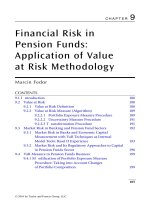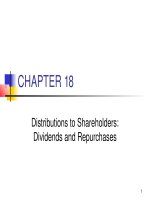Lecture Managerial finance - Chapter 30: Financial management in not-for-profit businesses
Bạn đang xem bản rút gọn của tài liệu. Xem và tải ngay bản đầy đủ của tài liệu tại đây (324.13 KB, 17 trang )
Chapter 30
Financial Management in
NotforProfit Businesses
Topics in Chapter
Forprofit (investorowned) vs. notfor
profit businesses
Goals of the firm
What are the key features of
investorowned firms?
Owners (shareholders) are well defined,
and they exercise control by voting for
the firm’s board of directors.
Firm’s residual earnings belong to the
owners, so management is responsible
to the owners for the firm’s profitability.
Firm is subject to taxation at the federal,
state, and local levels.
What is a notforprofit
corporation?
One that is organized and operated
solely for religious, charitable, scientific,
public safety, literary, or educational
purposes.
Generally, qualify for taxexempt status.
InvestorOwned vs. Notfor
Profit Businesses
Notforprofit corporations have no
shareholders, so all residual earnings
are retained within the firm.
Control of notforprofit firms rests with a
board of trustees composed mainly of
community leaders who have no
economic interests in the firm.
Goals for InvestorOwned and
NotforProfit Businesses
Because notforprofit firms have no
shareholders, they are not concerned with the
goal of maximizing shareholder wealth.
Goals of notforprofit firms are outlined in the
firm’s mission statement. They generally
relate to providing some socially valuable
service in a financially sound manner.
Is the WACC relevant to not
forprofit businesses?
Yes. The WACC estimation for notfor
profit firms parallels that for investor
owned firms.
WACC for InvestorOwned
and NotforProfit Businesses
Because notforprofit firms pay no
taxes, there are no tax effects
associated with debt financing.
A notforprofit firm’s cost of equity, or
cost of fund capital, is much more
controversial than for an investorowned
firm.
What is fund capital?
Notforprofit firms raise the equivalent
of equity capital, called fund capital, by
retaining profits, receiving government
grants, and receiving private
contributions.
The firm’s opportunity cost of fund
capital should rise as more and more
debt is used, and the firm should be
subject to the same financial distress
and agency costs from using debt as
encountered by investorowned firms.
Implementation Problems with
the Tradeoff Theory
The major problem is their lack of flexibility in
raising equity capital.
Notforprofit firms do not have access to the
typical equity markets. It’s harder for them to
raise fund capital.
It is often necessary for notforprofit firms to
delay worthy projects because of insufficient
funding, or to use more than the theoretically
optimal amount of debt.
Capital Budgeting for Notfor
Profits
The financial impact of each capital
investment should be fully understood in
order to ensure the firm’s longterm financial
health.
Substantial investment in unprofitable
projects could lead to bankruptcy and
closure, which obviously would eliminate the
social value provided by the firm to the
community.
What is social value?
Social value are those benefits realized
from capital investment in addition to
cash flow returns, such as charity care
and other community services.
What are municipal bonds?
Bonds issued by state and local
governments.
Municipal bonds are exempt from
federal income taxes and state income
taxes in the state of issue.
“Roll overs”
NotforProfit Health Care and
Municipal Bonds
Notforprofit firms cannot issue
municipal bonds directly to investors.
The bonds are issued through some
municipal health facilities authority.
The authority acts only as a conduit for
the issuing corporation.
Sources of Fund Capital
Excess of revenues over expenses
Charitable contributions
Government grants
Impact of Nonaccess to
Equity Markets
The lack of access to equity capital
effectively imposes capital rationing, so
the firm may not be able to undertake
all projects deemed worthwhile.
In order to invest in projects considered
necessary, the firm may have to take on
more than the optimal amount of debt
capital.









